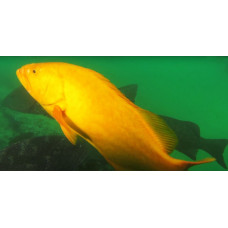Latin name
Saloptia powelli
Other names
Pink grouper, Powell's grouper
Identification
The golden grouper has a stout, elongated body with a depth of 2.6-3.1 times the standard length. The dorsal profile of the head is convex and the intraorbital region is flat. The forearm is not smoothly rounded, but neither is it steeply sloping, and contains three huge curved spines along the lower edge, as well as very fine serrations. The forearms are mostly covered with skin. The gill cover has a distinctly convex upper edge.
Features of fish fins
The dorsal fin contains 8 spines and 8 soft rays, the anal fin contains 3 spines and 8 soft rays. The caudal fin is pointed.
Fish colouring
The head, body and fins are yellow to orange-yellow, with the lower body white or pink. The snout, lips and upper part of the head are red, and the spines in the dorsal fin are sometimes marked with red veins.
Distribution
Found in the eastern Indian Ocean and western Pacific from Christmas Island and the South China Sea east to French Polynesia, north to Taiwan and Okinawa, and south to the Great Barrier Reef.
Habitat
An offshore, deep-water, bottom-dwelling fish. Usually found in schools, usually on rocky substrate covered with silt and barnacles, at depths of 100-200 metres (330-660 ft).
Size
This species reaches a maximum total length of 39 centimetres.
Behavior
Immature sea bass live in the areas to which they are transported by currents during their first year of life, without making large movements. Significant migrations do not occur until they reach sexual maturity.
Food and feeding habits
The diet of adult fish is dominated by crustaceans (gammarids and shrimps) and some fish species (capelin, anchovy, juvenile cod, whiting). Cannibalism is rare.
Reproduction
A live-bearing fish. Insemination occurs in February. After insemination, females congregate at sites where larvae are released. The larvae hatch all at once at a temperature of 5-7°C above deep water in March-June (peak in April-May). Larvae emerge fully formed with an almost dissolved yolk sac.
Fishing
It is caught in deep-sea fisheries and hunted in some parts of its range. This species is considered to be an excellent food fish.
| Classification | |
| Phylum | Chordata |
| Class | Actinopterygii |
| Squad | Perciformes |
| Family | Serranidae |
| Genus | Saloptia |
| Species | S. powelli |
| Features | |
| Conservation status | Least Concern |
| Habitat | Pelagic |
| Life span, years | No information |
| Maximum body weight, kg | No information |
| Maximum length, cm | 39 |
| Sailing speed, m/s | No information |
| Threat to people | Edible |
| Way of eating | Predator |
Golden grouper
Tags: golden grouper

